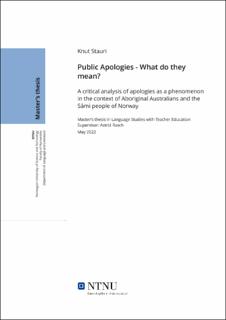| dc.contributor.advisor | Rasch, Astrid | |
| dc.contributor.author | Stauri, Knut | |
| dc.date.accessioned | 2022-07-09T17:20:00Z | |
| dc.date.available | 2022-07-09T17:20:00Z | |
| dc.date.issued | 2022 | |
| dc.identifier | no.ntnu:inspera:109722273:3339132 | |
| dc.identifier.uri | https://hdl.handle.net/11250/3004336 | |
| dc.description.abstract | I løpet av de siste tiårene har det vært en drastisk økning i offentlige unnskyldninger fra statsoverhoder eller stortingsrepresentanter (MacLachlan, 2010, s. 373). I kjølvannet av dette har forskere kritisert unnskyldninger
og stilt spørsmål ved deres sanne mening og hensikt (f.eks. Gibney & Roxstrom, 2001; Bentley, 2015). En av disse kritikerne er Dr. Tom Bentley, som har en doktorgrad i internasjonale relasjoner ved University of Sussex. Han har analysert fire mellomstatlige unnskyldninger og oppdaget at unnskyldninger har en tendens til å fremme interessene til stater som historisk har bedrevet kolonialisme. I tillegg skaper de nye diskurser og fortellinger som ligner holdninger fra den koloniale fortiden, som renvasker og legitimerer dem (Bentley, 2015, s. 5). Denne studien tar sikte på å analysere fire innenlandske unnskyldninger, ved å bruke Bentleys kritiske tilnærming til unnskyldninger som et rammeverk, for å se om funnene hans kan overføres til mine studier. Studien søker også å utforske hvordan talene endrer seg over tid. Bentleys kritiske rammeverk er delt inn i tre kategorier: renvasking og glorifisering, paternalisme og buktaling, som innebærer å snakke på vegne av andre. To av unnskyldningene er fra Australia til den australske urbefolkningen, og de resterende to er fra Norge til det samiske folket. Det er omtrent 14 år mellom de australske unnskyldningene og 20 år mellom de norske unnskyldningene. Resultatene indikerer at det er elementer av renvasking og buktaling i alle taler, men mindre glorifisering enn i Bentleys studier. Resultatene endres minimalt fra de første talene til de siste talene. Når det gjelder de australske talene, hevder jeg at den siste talen ser ut til å ha hatt en negativ endring. Når det gjelder de norske talene, kan funnene tyde på en positiv endring. | |
| dc.description.abstract | During the last decades, there has been a drastic increase in public apologies by heads of state or government representatives (MacLachlan, 2010, p. 373). In the wake of this, scholars have criticised them and questioned their true meaning and purpose (e.g., Gibney & Roxstrom, 2001; Bentley, 2015). One of these critics is Dr. Tom Bentley, who has a PhD in International Relations at the University of Sussex. He has analysed four interstate apologies and detected that they tend to advance interests of states that has historically engaged in colonialism, and that they create new discourses and narratives that resemble attitudes from the colonial past, which sanitises and legitimises them (Bentley, 2015, p. 5). This study sets out to analyse four domestic apologies, using Bentley’s critical approach to apologies as a framework to see if his findings are transmittable to my cases. The study also seeks to explore how the speeches change over time. Bentley’s critical framework is divided into three categories: sanitisation and glorification, paternalism, and ventriloquism. Two of the apologies are from Australia to the Aboriginal Australians, and the remaining two are from Norway to the Sámi people. There are roughly 14 years between the Australian apologies and 20 years between the Norwegian apologies. The results indicate that there are elements of sanitisation and ventriloquism in all speeches, but less glorification than in Bentley’s studies. The results change minimally from the first speeches to the last speeches. However, regarding the Australian speeches, I suggest that the most recent speech seems to have had a negative change. Regarding the Norwegian speeches, the findings could indicate a positive change. | |
| dc.language | eng | |
| dc.publisher | NTNU | |
| dc.title | Public Apologies - What do they mean?
A critical analysis of apologies as a phenomenon in the context of Aboriginal Australians and the Sámi people of Norway | |
| dc.type | Master thesis | |
